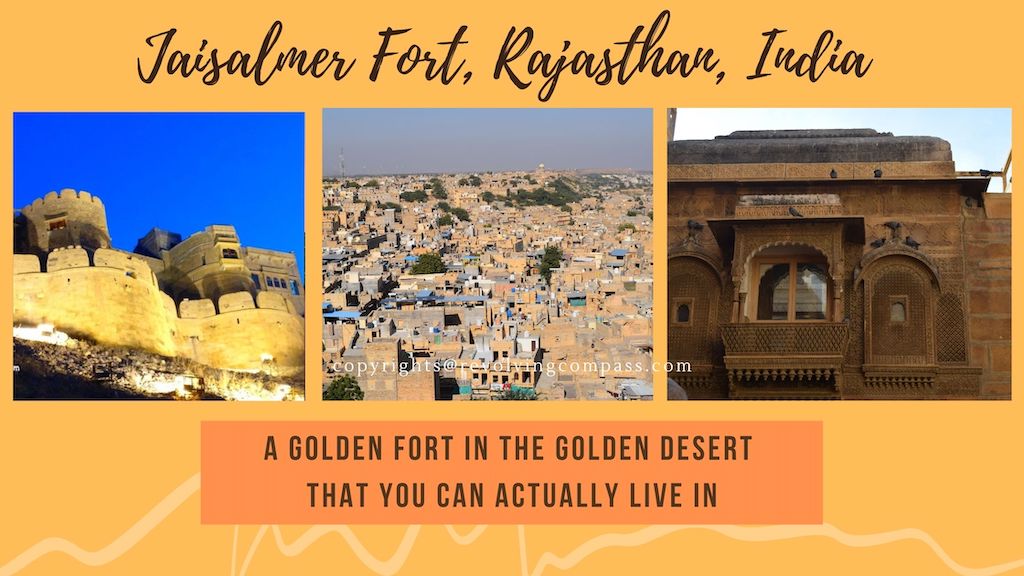
Camouflaged in the golden desert, stands tall a massive sandstone fort,
Casting a protective shadow over the golden city of Jaisalmer.
Basking like gold in the bright daylight,
It slowly turns honey – mustard as the evening arrives.
And finally assimilates in the vast expanse of desert around it as night draws in!
And that is the Jaisalmer Fort. See how it turned me poetic! Not only did we visit this fort on our trip to Jaisalmer & The Thar Desert, but we actually lived here!! . Yes you heard us right. Jaisalmer Fort is one of the very few living and lively forts in the world (One fourth of the old city population actually resides within the Jaisalmer fort!). Also, at the same time, it is a world heritage site. And these are things that truly set it apart from the other grand forts that we visited in India. Including the Chittorgarh Fort, Kumbhalgarh Fort, Amer Fort, Jaigarh Fort, Nahargarh Fort, Mehrangarh fort and countless others.
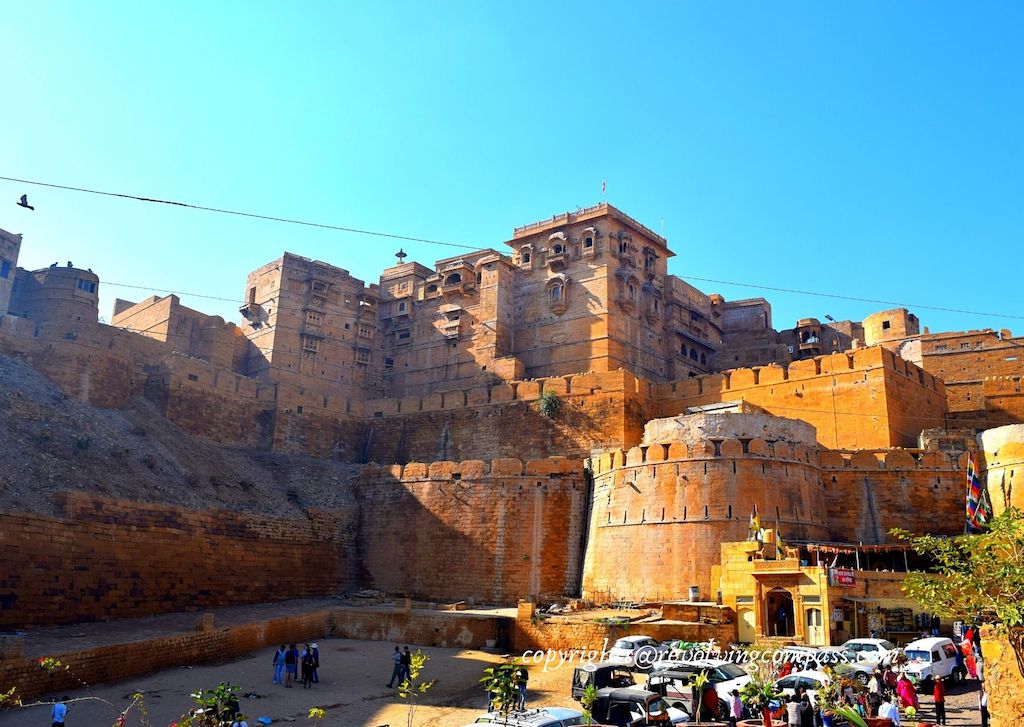
There are shops, hotels, restaurants, home-stays and what not inside the fort. So in case you want to live like the Royal for a few days, book your stay right inside Jaisalmer Fort when you happen to visit here. The night views of the city, the uninterrupted golden stretch soaked in the morning sun, the buzzing fort life…it all totally makes it worth staying here.
An Intro to Jaisalmer Fort
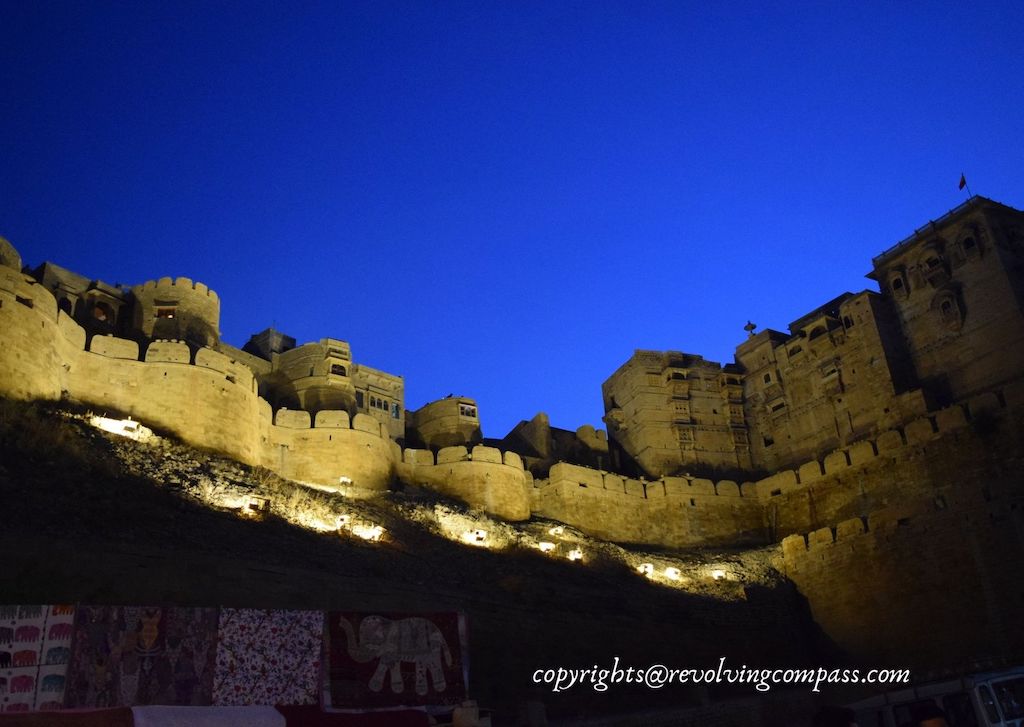
The Jaisalmer Fort was built by Rawal Jaisal in the 12th century. Built atop a 250ft high hill, the fort itself is 1500ft long and 750ft wide, and has 99 bastions. Apart from the strategic location, the prophecy of a saint also compelled Rawal Jaisal to build his fort here. As per the saint, only a descendant of Lord Krishna would conquer the hill with his fort!! The fort has a unique triple ring defence architecture where the outermost wall stands a massive 15 feet tall. Followed by 2 layers of inner walls.
Also, Jaisalmer fort has 4 main entrance gates from four different directions – Ganesh Pol, Suraj Pol, Akshaya Pol and Hawa Pol. As you enter the fort from one of these 60ft high doors, you can’t help getting impressed. The main gate that is right in front of the old town is used as the entrance gate by tourists now a days. The significant parts of the fort that are also points of tourist interest include the following
The Raja ka Mahal Palace (Maharwal Palace)

The Raj Mahal is the main palace inside Jaisalmer Fort where the king resided. Its intricate architecture immediately reminds one of the other forts of Rajasthan, particularly Mehrangarh Fort. However, right before entering the palace, the first thing you notice is the saffron – orange hand prints. These were made by the women of the fort before they committed Johar in the Dussehra Chowk or Manak Chowk. This palace feels very compact when compared to the other palaces of Rajsthan like the expansive city palace of Udaipur, the Jaipur palace or even the palaces inside Amer Fort and Mehrangarh Fort. However, the Raj Mahal Palace does span over several storeys. And comprises of a lot of balconies, small courtyards, jharokhas and chambers.

A major portion of this fort now hosts a museum where the material possession of the royal family, weapons, dresses and other such things are displayed. After the museum one comes across Diwan-e-khas. Where the main guests of the palace were received. From here, you get into the private residence of the kings. The floral carvings in the sandstone in this area are particularly eye catching. And the intricate carvings on the windows and jharokhas are also noticeable. This part of the palace is called Gaj Niwas. And through an open courtyard it connects to the Queen’s chambers or the Rani ka Mahal.
The Rani ka Mahal Palace

The other quarter of Raja ka Mahal Palace, right adjacent to it, is the Rani ka Mahal or the Queen’s Palace. It’s a little smaller than the Raj Mahal Palace but exhibits similar intricate carvings, balconies and jharokhas made of sandstone. As the name suggests, this part of the palace was used by the queen, the royal ladies and their female servants. Although a very small portion of this part of the palace is open to the visitors as of today. Particularly noticeable among them is the Goddess Gori Idol and depiction of celebration of Gangaur Festival. After visiting these sections, one comes out from the main door of the Rani Mahal, into the Dussehra Chowk.
Overall, there is a prevalent sewage issue in the Jaisalmer Fort and these palaces. You can feel the dampness while roaming around the chambers of the palace. And also in the streets of the fort. Although restoration measures are being taken. But if it continues then the palace can even collapse. Hope the issue is resolved within time. It will be painful to loose such a glorious and historical landmark.
Jain Temples of Jaisalmer Fort

A small alleyway right from in front of the Raj Mahal leads to three beautiful Jain Temples inside the Jaisalmer Fort. Although you do have to take a few left and right turns in the narrow lanes before you reach at the temples. These temples have the beautiful intricate sandstone work typical to that of a Jain Temple in Rajasthan. Although they are very small compared to the massive Jain Temple of Ranakpur. But one can’t help compare. We didn’t visit these temples after visiting the palace. But rather walked here the next day early in the morning. Because we were staying right inside the fort. However, if you are doing a day tour of the fort, then visit these temples next.

Overall there are 7 different Jain Temples inside Jaisalmer Fort but these 3 are the major ones. Each of the Jain Temples is dedicated to a different Jain Teerthankar. If you have limited time, we highly recommend visiting the Parshwanath Temple, which is the most beautiful and impressive of all these Jain Temples. Apart from the beautiful architecture, there are two other things that these Jain Temples are particularly famous for. One – they are believed to have secret passageways leading all the way out of the Jaisalmer Fort. These were used as the escape routes for the Jain when the fort was under attack. And two – they are believed to host a rare Jain Script.
Related read : A complete guide to visiting Jaisalmer Rajasthan
Lakshminath Temple
Made by yet another ruler of Jaisalmer, Rao Lunkaran in the 19th century, the Lakshminath Temple is a temple dedicated to Goddess Lakshmi (the Hindu Goddess of wealth) and Lord Vishnu. This temple is right besides the Jain Temples. So, one can pay a quick visit and offer their prayers here after visiting the Jain Temples.
Alley ways inside the Jaisalmer Fort
There is something about the magical , maze streets and narrow lanes inside Jaisalmer Fort. That you feel like simply navigating them and getting lost. Surrounded by massive fort quarters that mostly host shops on the lower floor and restaurants or guest houses on the upper one, these streets are a destination in themselves. They remind one of the narrow lanes of Varanasi. Or the tight lanes of Santorini. They all seem to lead to the Dussehra Chowk at some point. It is indeed fun to navigate through them and reach your destination.

Accommodation inside the Jaisalmer Fort
Most of the hotels inside Jaisalmer Fort are reasonably priced. And then there are guesthouses and homestays. In fact, every other building has some kind of accommodation available. And why not. Tourism is the main source of income for the people of Jaisalmer now. And you will find both short term and long term booking options available. Do check for airy and specious options. As some of the quarters are very tight and the rooms cramped. We did stay inside the Jaisalmer Fort. In Hotel Raj Mandir. It was a simple accommodation. But the warmth of the hosts just set it apart. I guess there is something about the hospitality of the people of Jaisalmer that makes everything magically comfortable!

Food inside Jaisalmer Fort
The Jaisalmer Fort is as pleasing to the appetite as it is to the eyes :D. You never have to worry about where to eat in Jaisalmer Fort. For, the fort is dotted with several restaurants, cafes and home like kitchenettes apart from of course the street food vendor carts and roadside eateries. These range from the traditional Rajasthan food, Indian cuisines from across the country, Italian, Continental and even multi-cuisine restaurants. We particularly had a great time at two different restaurants. A multi-cuisine restaurant right near the entrance. Where we had 2-3 meals. And our kid especially seemed to enjoy their Italian food. One dinner experience here was particularly delighting, with a young group performing folk singing. While we had our dinner under the stars on an open roof. In dim candlelights, sitting on colourful floor cushions with colourful Rajasthani turbans on our head!

Apart from this, we had dinner in the restaurant of a homestay guesthouse right besides our hotel, Raj Mandir. This one had cute jharokha window sittings. And from there, one gets mesmerising view of the fort and the expanse of the Jaisalmer city beyond that, particularly at night. Also, we had our breakfast on the roof of our own hotel. Although it comprised of a simple breakfast in terms of variety but the warmth with which it was served and the views from atop the fort roof simply won our heart. And every single item was freshly cooked right after ordering. Also, they were super delicious and homely.
Shopping in Jaisalmer Fort
There is a plethora of shops all over the Jaisalmer Fort. And the variety of things that you can buy is also huge. Right after the entrance there are some shops and some government emporiums selling linen, dress materials, home furnishing, silver jewellery, antique decor items, small souvenirs etc. Near the palaces you will find several shops selling hand painted posters, t-shirts and dresses. In many of these you can even see the artist sitting right inside the shop and painting. In the alleys that lead to the Jain Temples, you can find small shops selling dress materials, dresses and home linen. Some furniture shops are also there.

In conclusion, Jaisalmer Fort has a world inside itself. In fact, it is the soul of the Jaisalmer city. You don’t even need to step out until you want to visit some other attractions inside Jaisalmer town like the palaces of Nawabs, the Gadisar lake, the cenotaphs of Bada Bagh, Khaba Fort, Kuldhara and other such places. Just get lost in the narrow alley ways , shop till you drop, hear the numerous stories of the Kings and their kins, eat mouth watering multinational cuisines, relax by the soothing traditional songs and watch the city twinkle like stars in a galaxy below you during the night. What else one needs to satisfy the wanderlust!!!
Visiting Jaisalmer Fort

If you are not staying within the Jaisalmer Fort, dedicate a day or two to explore the fort and all that it has to offer. As you arrive at the main gate, you will see crowds building up as early as 10:00am in winter months which is also peak tourist season. Start from the main gate and walk to the Raj Mahal Palace. The shops on both sides that line the initial 500 metres or so are a temptation and a distraction too. But resolve to return to them after you have visited the palace and temples. As you follow the main road, you soon arrive at a small square called Dussehra Chowk. On one side of the square, a narrow lane leads to a flight of stairs on the side, inside the Raj Mahal Palace.
After visiting the Raj Mahal, proceed to the Rani Mahal Palace, that is just adjacent to it on the other side of the main road. And then proceed to visit the trio of Jain Temples which are inside a narrow street opposite to the Palaces. After having visited these, enjoy a meal in one of the restaurants inside the fort premises. Do some shopping on your way back. Below is a map for your reference:
General tips on visiting Jaisalmer Fort
- Wear comfortable shoes as there will be a lot of walking to be done.
- In winter, the days are hot and the nights tend to get cold. Wear layers. Add a layer – cotton cloths during the day and a light sweater or jacket towards the evening.
- There are many food and refreshment options inside the fort. But there is a lack of public toilets. You can use one inside the Raj Mahal Palace.
- Also, when taking a guided tour, do negotiate the price. As the guide fee is not fixed here and a bit of bargaining pays off.
PS: Some of our links are affiliated, this means we will earn a commission when you buy a service or product by clicking those links. However, this will have no extra cost for you.
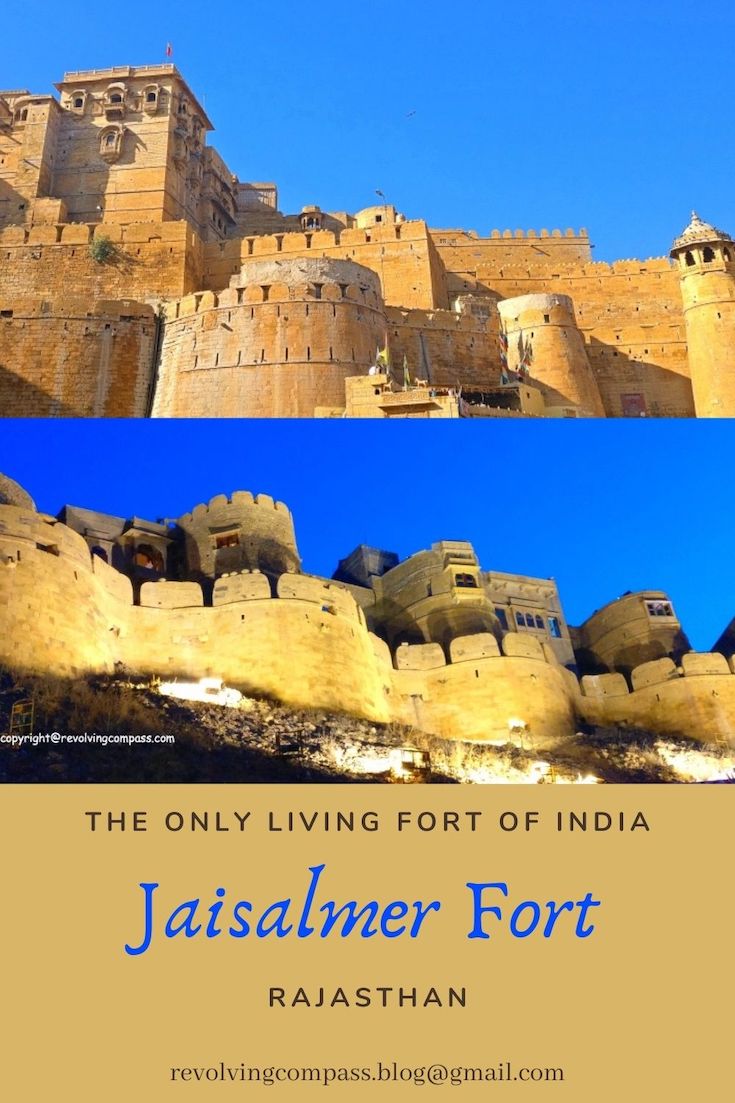 |
 |
 |
 |
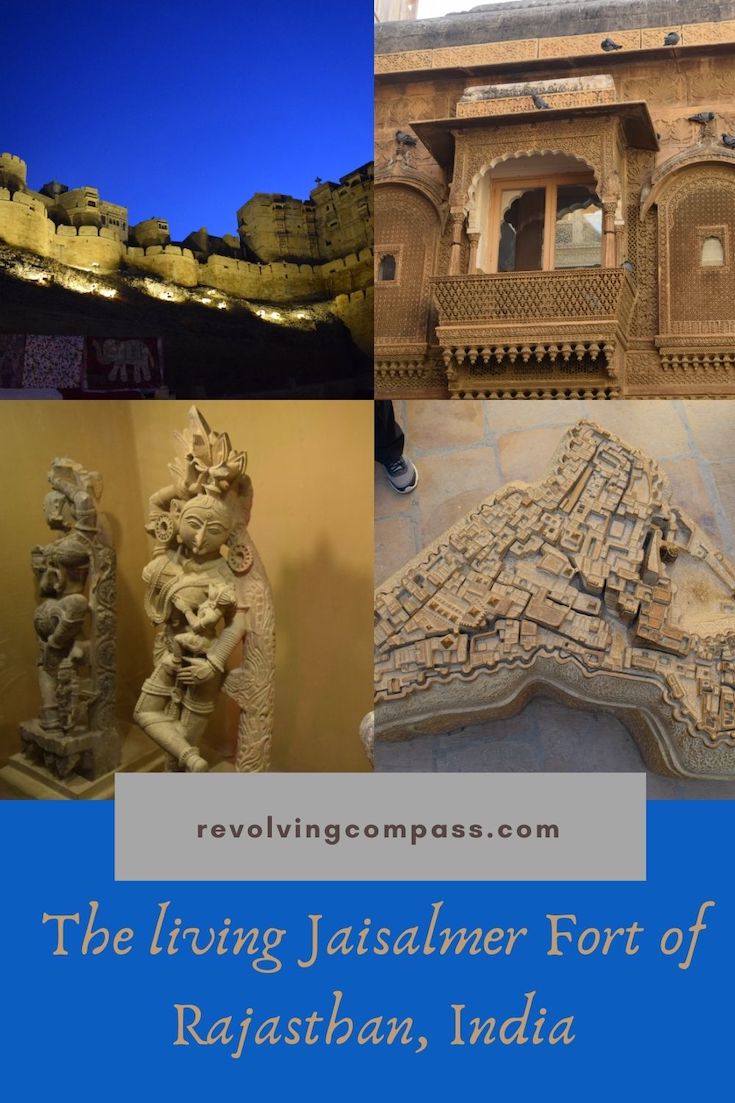 |
 |
Thanks for Information , Rajasthan Top Tourist State Of India for Culture & Heritage & Jaisalmer Special for Desert Safari